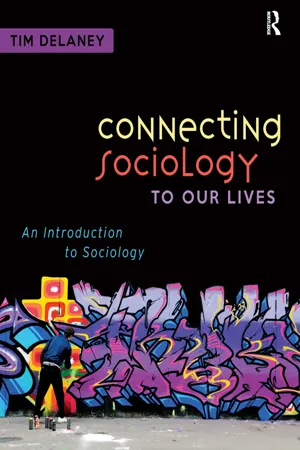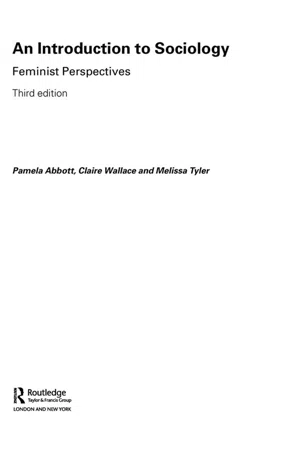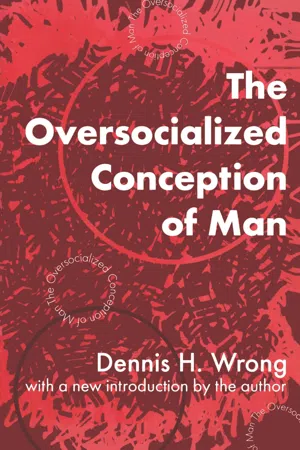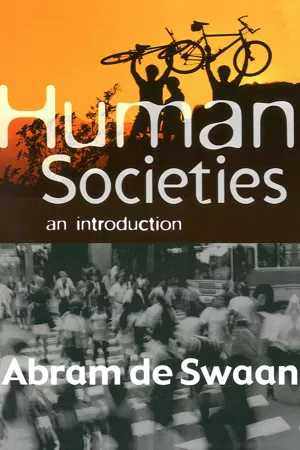Social Sciences
Social Stratification Theories
Social stratification theories seek to explain how and why societies are divided into hierarchical layers based on factors such as wealth, power, and social status. These theories explore the impact of inequality on individuals and groups, and how it shapes their opportunities and life chances. They also examine the mechanisms through which social stratification is perpetuated or challenged within societies.
Written by Perlego with AI-assistance
Related key terms
10 Key excerpts on "Social Stratification Theories"
- eBook - ePub
Connecting Sociology to Our Lives
An Introduction to Sociology
- Tim Delaney(Author)
- 2015(Publication Date)
- Routledge(Publisher)
Because members of a higher rank enjoy privileges over their lower-ranked counterparts, social stratification may be viewed as institutionalized social inequality. Taking into account these key components, sociologists define social stratification as a system for ranking members of a social system into levels with different or unequal evaluations. In this regard, social stratification reveals patterns of social inequality found within a society. From the sociological perspective, social stratification may also be viewed as the hierarchal or horizontal division of society based on rank, strata, or social class. All societies are characterized by a stratification dimension that places people in some sort of social stratum or classification system. This classification system leads to the development of socioeconomic classes. Sociologists use the term “social class” to describe a broad group of people with common economic, cultural, or political status (e.g., the working class or the professional class). Dimensions of Social Stratification Most societies have three major dimensions of stratification: social prestige, political power, and economics. The social prestige dimension of stratification is tied to what people think about others. Generally, people who are thought highly of have high prestige or social status. In contrast, those who are thought of negatively have a low level of prestige. There are many ways to attain social prestige, including family name, geographic residence, level of education, occupation or career, public exposure, accomplishments, social titles, and celebrity status. We take a closer look at many of these social-prestige variables later in this chapter during our discussion of theories of social stratification. The political dimension of stratification is usually expressed in terms of power - eBook - ePub
- Rosemary Crompton(Author)
- 2015(Publication Date)
- Polity(Publisher)
2 APPROACHES TO CLASS AND STRATIFICATION ANALYSISIntroduction
All complex societies are characterized, to varying extents, by the unequal distribution of material and symbolic rewards. The study of the causes and consequences of these inequalities is the major focus of class and stratification theorists and researchers. As we shall see in this book, the range of issues and topics falling within this broad rubric is immense, and the concepts, theories and measures developed to address these topics have often been the subject of extended (and sometimes acrimonious) debates. Nevertheless, common to all sociological conceptions of class and stratification is the argument that social and economic inequalities are not ‘natural’ or divinely ordained, but rather, emerge as a consequence of human behaviours.‘Social stratification’ describes the hierarchical ordering of social relationships, and is a general term which describes these systematic structures of inequality. The terms ‘class’ and ‘stratification’ are often used interchangeably. However, without drawing a hard and fast distinction between the two, it is useful to think of ‘stratification’ as the more general term. Hierarchical positioning in the social order, at both macro- and micro-levels, is all-pervasive. It can draw upon a number of different dimensions, both material and cultural. Thus positioning in a stratification order is an outcome of a wide range of factors including the extent of social recognitions and esteem, gender, age, ethnicity, income and other material resources, knowing how to behave (and the people you know) as well as other characteristics – religious affiliation, for example, might be crucial in some societies but not in others. In contrast, the term ‘class’ is often reserved for descriptions of material inequalities and their origins – and indeed, as we shall see in the following chapters, many sociologists insist on a sharp distinction between ‘class’ and ‘status’ (or hierarchy). - eBook - ePub
- Vijai P. Singh(Author)
- 2017(Publication Date)
- Routledge(Publisher)
This pattern of increasing inequality reaches its peak in agrarian societies, but reverses itself in advanced industrial societies. Power is central to the distributive sytsem; however, it is fluid and shows variations in its effect in different historical periods and in different technological contexts. In advanced industrial societies, for instance, social, economic and political structures become more differentiated and various occupational groups engage in bargaining which results in a more equitable distribution of society’s resources. 43 Whether Lenski succeeded in his initial aim of developing a synthesis theory may still be debated by many, but his attempt has certainly provided a less rigid approach for studying stratification. The Concept of Social Stratification Currently, there is a reasonable degree of agreement among social scientists regarding the definition of social stratification. Social stratification refers to the process of placing differentiated social units along an idealized continuum, or to the conceptualization of these social units into categories which share a relatively common position with respect to a socially validated scale of specific or generalized characteristics. These units may be individuals, families, classes, nations or any identifiable unit that one might conceptualize in an hierarchial order. In principle, a stratification system can be unidimensional or multidimensional. The type of system should be based upon the kind of society that is being studied and the nature of association among the elements of the stratification system. In other words, “a society characterized by perfect correlation between all relevant criterion variables has a one dimensional stratification system. Conversely, one in which the average correlation is lower will be multidimensional - eBook - ePub
- Ken Browne(Author)
- 2019(Publication Date)
- Polity(Publisher)
- Make a list of what you consider to be the most important inequalities in society today. Explain in all cases why you think they are important in people’s lives and how they affect the chances people get in life.
Much of this book, and particularly this chapter, is concerned with describing and explaining a range of these inequalities.WHAT IS SOCIAL STRATIFICATION?Inequality affects not simply individuals, but whole groups of people, and such patterns of inequality between social groups are calledsocial stratification.Social stratification The division of society into a hierarchy of unequal social groups.The word ‘stratification’ comes from strata or layers, as in the way different types of rock are piled on top of one another to form rock strata.Social stratification refers to the division of society into a pattern of layers or strata made up of a hierarchy of unequal social groups. These stand in relations of advantage and disadvantage to one another in terms of features such as income, wealth,occupational status(see glossary box ), religion, race, age or sex, depending on the stratification system. Those at the top of the stratification hierarchy will generally have more power in society and better life chances – such as educational success, good-quality housing, better health, longer holidays, and more secure and better-paid jobs – than those at the bottom.Occupational status - eBook - ePub
An Introduction to Sociology
Feminist Perspectives
- Pamela Abbott, Melissa Tyler, Claire Wallace(Authors)
- 2006(Publication Date)
- Routledge(Publisher)
Sociologists use the term stratification to refer to a structure according to which individuals and groups are positioned within a social hierarchy in which some groups occupy more powerful and privileged positions than others – in a class, caste or gender system, for instance. Macionis and Plummer (2002) argue that social stratification is:- a characteristic of society – not simply a reflection of individual differences or competences;
- persistent over generations (although some individuals do experience social mobility – see below);
- universal but variable – stratification is a feature of all societies from the simplest to the most complex, but what counts as inequality varies between and also within societies;
- not simply material but also based on belief systems – just as what constitutes inequality varies between societies, so do explanations of why people are unequal, as does the basis on which people might come to be thought of as inferior.
The basis of stratification – the division of people according to a hierarchical system – varies from society to society. Divisions may be based on sexual difference, social class, race and ethnicity, culture, disability, age, and so on. Feminist writer Iris Marion Young (1990a, pp. 49–59) has identified a number of social processes at work in the stratification of societies into hierarchical orders. These include:- social exclusion and marginalisation – a process by which ‘a whole category of people is expelled from useful participation in social life’;
- exploitation – through which there is ‘a transfer of the results of the labour of one social group to benefit another’;
- powerlessness – whereby ‘people come to lack the authority, status and sense of self that many professionals tend to have’;
- cultural imperialism – involving ‘the universalization of a dominant group’s experience and culture, and its establishment as the norm’;
- violence – directed at members of a group simply because they belong to that group (examples of which might include violence against women, racial violence and homophobia).
Sociologists have tended to argue that in capitalist societies the primary form of stratification is based on social class. However, sociologists disagree about what constitutes class, and how it is determined. Some argue, for instance, that countries such as Britain and the US are increasingly ‘classless’. Others emphasise that class is no longer defined by production (the occupational group to which we belong, or by our income) but by consumption (our spending patterns and the kind of lifestyle we adopt). Most sociologists maintain, however, that - eBook - ePub
- FRANK Parkin(Author)
- 2018(Publication Date)
- Routledge(Publisher)
Unfortunately, however, to say this still does not yield a check list of standard parameters whose value the researcher into any given society can in practice settle down to ascertain. First of all, differences in levels of culture and economic development are such that the list appropriate for one society may be altogether less appropriate for another. Second, many (perhaps most) aspects of stratification are not, or not yet, sufficiently amenable to precise definition and measurement. Third, the list which any researcher adopts in practice will be influenced, and rightly so, by his own particular concerns and by his view of the likelihood that one selection rather than another will generate the more powerful hypotheses about the relations either between stratification parameters or between one or more stratification parameters and some other independent variable or variables (a notable example is Andreski 1954). At the most general cross-cultural level, there are five questions which any researcher concerned with stratification will be bound to ask about any society he studies: first, who rules and who is ruled?; second, how are material goods and services allocated?; third, what degree of deference, or institutionalized respect, is accorded by who to whom ?; fourth, among how many (if any) externally distinguishable, institutionally ranked groups or quasi-groups whose members acknowledge some common economic and/or social and/or political interest can the members of the society be said to be distributed ?; fifth, what are the rates of social mobility between such groups or, in their absence, between vertically differentiated roles or positions? But the greater the detail in which the researcher tries to answer these questions the more likely he is to want to adopt not only techniques but also concepts which will differ widely according to the type of society in question.The first stage, therefore, in the development of a theory of stratification must be the deliberately simplified description of a sample of societies (or communities - a point to which I shall return in a moment) in terms of a highly selected and perhaps quite loosely defined set of parameters, which relate more or less directly to these five fimdamental questions.It does not, however, follow from this that the most useful way to proceed at the following stage will be to try to establish inductive correlations between the values of the chosen parameters out of which presumptive laws might in the end be constructed. The approach for which I wish to argue in this paper calls rather for a specification of the range within which these values can be shown to vary and a demonstration of the way in which indentifiable constraints so act on stratification systems as to limit the values which might otherwise be observed. It is almost certainly unrewarding to try to generalize about stratification in terms of a direct correspondence between ecological or cultural variables on the one hand and the parameters of stratification on the other. No doubt such correspondences are somewhere implicit in any would-be theory of stratification. But to make them the initial goal of such a theory is to risk underemphasizing the dynamic, or if you prefer historical, aspect of stratification systems and the degree to which their evolution must be understood in terms of a continuing dialectic not only between the mode and the relations of production but between the conflicting goals being deliberately pursued by different groups, quasi-groups, and strata. - eBook - ePub
The Sociology of Education
An Introduction
- Ivor Morrish(Author)
- 2019(Publication Date)
- Routledge(Publisher)
As we come to consider some of the relationships between social stratification and education we must bear in mind that, in all the variety of theories concerning class and group structure, certain vital facts emerge regarding such concepts as power, status, prestige, life chances, life-styles, patterns of consumption, leisure activities, and occupations. These are concrete facts amongst a considerable amount of abstract theorizing, and they are closely related to problems of culture, education and socialization. In all the ramifications of the literature on class and social groupings it is not easy for anyone, whether pundit or dilettante, to obtain any final and clear-cut view on social stratification. Human personality and development, whether considered in group or in individual terms, defies the strictly statistical analysis that so many seek in the sociology of the future.At least Dahrendorfs analysis recognizes the problem of the increasing number of 'classless' individuals who, as 'floating intellectuals', wander through the many areas of society, doing everything from working in sewers, singing pop-songs, producing or otherwise participating in TV shows, to lecturing in colleges and universities. But, no doubt, B. S. R. Green and E. A. Johns are right in their conclusion on the question of class:'While it may be agreed that socio-economic changes in our own society have largely invalidated the class conflict model, it must not be assumed that the concept of social class has been made irrelevant. The fact remains that people can be classified according to occupational prestige, income, education or other closely associated indicators of social status and that such classifications are not merely statistical categories but reflect differences in values, goals, attitudes and behaviours. For example, high social status is associated with greater political involvement, with more favourable attitudes towards further education and with a more rational mode of decision-making in such situations as occupational choice' (30) .D. Social Class and Education
In this section we are mainly concerned with the effects of social class or stratification upon education. In Chapter 8 - eBook - ePub
- Dennis H. Wrong(Author)
- 2018(Publication Date)
- Routledge(Publisher)
Structural-functional theorists consider societies to be coherent “systems” largely held together by a consensus on basic values. They are predisposed, therefore, to see social inequalities as the inevitable result of “differential evaluation” of roles and activities according to a shared value-system. They then equate the scale of invidious valuation with “social stratification” or the “social class system,” frequently seeing the latter as identical empirically with status rankings of occupations such as the North-Hatt scale. 22 Given the theoretical commitment of structural-functionalists to the view that common values should be the main focus of sociological analysis, this practice has become so ingrained that alternative conceptions of stratification are regarded as eccentric and the whole issue is treated as one of terminology and conceptual nominalism, as if it made no empirical difference whether classes in the traditional sense existed or not. 23 Nevertheless, the debate over the so-called functional theory of stratification has done a great deal to clarify our understanding of the limits to human equality in societies with an elaborate division of labor. And one of the creators of the most widely discussed version of that theory has recently acknowledged that it is a theory of inequality rather than of stratification and that it “does not presuppose” the “conceptual category” of class. 24 Finally, there is an ideological bias. Celebrations of the United States have traditionally affirmed its “classlessness” and at the same time extolled the equality of opportunity to attain the unequal rewards it allegedly provides. In challenging the reality of the latter, sociologists have been unwilling to concede any truth to the claim of classlessness lest they should appear to be denying the facts of inequality and barriers to opportunity - eBook - ePub
Human Societies
An Introduction
- Abram De Swaan, Beverley Jackson(Authors)
- 2013(Publication Date)
- Polity(Publisher)
social mobility . This mobility may manifest itself within an individual’s life, but it may also occur from one generation to the next. Often the son will achieve more than his father, and the granddaughter will go further still: the father was a peat worker, the son becomes a schoolteacher and the granddaughter may make it to professor. In caste societies social mobility is rare, in class societies it occurs more often because of the greater emphasis on achievement than on family background: positions are more often attained than ascribed. Most parents cannot leave their children a large amount of capital, nor can they offer them prospects within a family business; what they can do, however, is provide them with a good education, which will become their cultural capital. Formal education has increasingly become the primary factor determining the scope for upward social mobility from one generation to the next.Every complex society is characterized by stratification: the formation of social layers that differ in terms of power, property and prestige. A high position in one ranking order can enable people to improve their position in the others through ‘status conversion’. Social mobility from one layer to another is something that occurs largely in societies with a less rigid and sharply defined stratification.5 Relations between men and women
Early social science paid little attention to the special position occupied by women in society. Research was regarded as men’s work and there was a tendency to speak of people in general without looking at the specific conditions of women’s lives. Clearly, social science is itself afflicted by the short-sightedness and prejudices it sets out to study in others. This relative neglect of women has been much improved over the past few decades, and this too has been caused by social factors: more girls attend school than in the past, more young women are employed outside the home, and more study and teach at university, particularly in social science. All these developments have heightened interest in women’s position in society, especially among researchers.Unequal social relations exist between men and women. The inherent sexual differences are moulded socially into gender differences that vary from one society to the next. However, the differences between the positions occupied by men and women are related not only to gender but also to the position occupied by a woman’s parents or husband. A woman attached by birth or marriage to a prominent man may be held in higher regard, be wealthier and have a stronger position of power than a man from a humbler background – the managing director’s wife may be driven about by a chauffeur. At the same time, she will be held in less high regard, will have less property and less power than most of the men in her surroundings. Thus men and women do not constitute two separate social layers; within each layer, in all kinds of social surroundings, in every family, there is a large chance that the women will be at a disadvantage relative to the men. This gap is closing in present-day Western societies. - eBook - ePub
- Anthony Giddens, Philip W. Sutton(Authors)
- 2021(Publication Date)
- Polity(Publisher)
Some are largely descriptive, reflecting the shape of the occupational and class structure in society without addressing relations between social classes. These models have been favoured by scholars who see stratification as unproblematic and part of the natural social order, such as those working in the functionalist tradition. Functionalism was introduced in chapter 1, ‘What is Sociology?’, and chapter 3, ‘Theories and Perspectives’. Other schemes are more theoretically informed, drawing on the ideas of Marx or Weber and concerned with explaining relations between classes in society. ‘Relational’ class schemes are favoured by sociologists working within conflict paradigms in order to demonstrate the divisions and tensions in society. Erik Olin Wright’s theory of class, discussed above, is an example of a relational class scheme, because it seeks to depict the processes of class exploitation. John Goldthorpe’s influential work, originally rooted in Weberian ideas of class (see ‘Classic studies’ 9.2), is another example of a relational scheme. As ‘Classic studies’ 9.2 notes, the EGP class scheme has been widely used in empirical research. Yet it is important to note several significant limitations to all such schemes, which caution us against applying them uncritically. Clearly there are complexities involved in devising schemes that can reliably ‘map’ the class structure of society
Learn about this page
Index pages curate the most relevant extracts from our library of academic textbooks. They’ve been created using an in-house natural language model (NLM), each adding context and meaning to key research topics.









